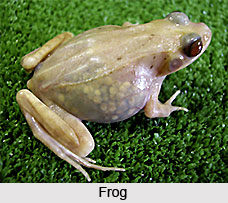 The name Amphibia means `having two lives`; is an apt description for a class of animals who live an aquatic fish-like existence when young, and become terrestrial when adult. Thus the name `amphibia` is applied to a class of vertebrates that fall between the fishes and the reptiles. They differ greatly in form, and range from the legless, worm-like caecilians to the lizard-like salamanders and newts. Some of the major differences that separate amphibians from the other vertebrates are a body covered with generally moist skin without scales, fur or feathers; soft toes with no claws; a two-chambered heart in the larval stage and a three-chambered heart in adults; external fertilization of eggs; and the process of metamorphosis.
The name Amphibia means `having two lives`; is an apt description for a class of animals who live an aquatic fish-like existence when young, and become terrestrial when adult. Thus the name `amphibia` is applied to a class of vertebrates that fall between the fishes and the reptiles. They differ greatly in form, and range from the legless, worm-like caecilians to the lizard-like salamanders and newts. Some of the major differences that separate amphibians from the other vertebrates are a body covered with generally moist skin without scales, fur or feathers; soft toes with no claws; a two-chambered heart in the larval stage and a three-chambered heart in adults; external fertilization of eggs; and the process of metamorphosis.
Amphibians were the first land animals. The first records are from the early Devonian and late Silurian times. These remains are associated with freshwater fish-like animals. The rise of the Amphibia from their fish-like ancestors required radical changes. For instance, the evolution of limbs from fins, a breathing apparatus that could function effectively in air, and a skin that could remain moist. These changes were accomplished very slowly.
The early forms were all four-legged and tailed but were mainly aquatic. The habitat of Eogyrinus, one of the earliest known amphibians, seems to have been temporary pools in arid areas, where the drying of the pools would have caused it to make overland journeys to other pools. From these modest beginnings, amphibians have evolved to occupy practically all known habitats except some of the more climatically extreme, such as the polar areas.
At present the Class Amphibia is represented by three Orders: the Apoda, which encompasses the worm-like Caecilians, the Caudata or `tailed amphibians` that are represented by Newts and Salamanders, and the Saliefitia which includes the Frogs & Toads.
In most amphibians, eggs are fertilized externally. The female may lay the eggs individually or in strings. The eggs absorb water rapidly after they are laid, and after a certain stage cannot be penetrated by the sperm. This requires the sperm to be in contact with the eggs immediately after laying. The familiar clasp or embrace of mating frogs enables the male to release the sperm almost directly after the eggs are released.
 The eggs vary in size from 2 to 8 mm. Large eggs are common in tailed amphibians, which live in swift water, and in those frogs and toads which have direct development.
The eggs vary in size from 2 to 8 mm. Large eggs are common in tailed amphibians, which live in swift water, and in those frogs and toads which have direct development.
On hatching, a larva emerges from the egg. In the frogs and toads, this is the tadpole. In the other orders it may be larvae that resemble the adult. Immediately after hatching, the tadpole remains immobile, eating the remnants of the yolk sac. Most amphibian larvae usually start off with external gills but tadpoles generally have internal gills.
In some amphibians, the larval stage is accomplished while in the egg. This allows fully formed young frogs or newts to emerge from the egg. The species exhibiting this adaptation usually breed away from water.
Some amphibians even carry their eggs and tadpoles on them. No clear records exist for Indian amphibians carrying eggs or tadpoles.
Usually, amphibians lay their eggs in a suitable habitat and the eggs are left to hatch and develop by them. There are some species that have developed `nests` to afford the eggs more protection. The tree frogs of the family Rhacophoridae are one such group. They are foam-nest builders. The male uses his hind legs to whip up the albumen extruded with the eggs into a thick froth. The whole frothy mass is suspended from a tree or bush above a suitable body of water, into which the tadpoles will drop when hatched. The caecilian Icthyophis is known to excavate a burrow and coil round its eggs to protect them till hatching.
Amphibians possess a vast repertoire of sounds from monosyllabic `grunts` to complicated bird-like calls. Of the three living orders of amphibians, only two have been known to produce any vocalization that is the frogs and toads, and the tailed amphibians. However, vocalization in the newts and salamanders is rare. All the amphibian calls one hears on the Indian subcontinent come from frogs and toads.
Although calls to attract mates are the commonest uses of voice in amphibians, there are five other conditions which may give rise to sounds. These sounds are called release calls, warning sounds, rain calls, screams, and territoriality calls.
 Amphibians are subject to enormous predation. From the egg to adult, they form a part of the diet of innumerable enemies. The length of life in the amphibians has been recorded to vary from as short as two years in the spade foot toads to as long as fifty years for some salamanders; the larger animals generally live longer than the smaller ones.
Amphibians are subject to enormous predation. From the egg to adult, they form a part of the diet of innumerable enemies. The length of life in the amphibians has been recorded to vary from as short as two years in the spade foot toads to as long as fifty years for some salamanders; the larger animals generally live longer than the smaller ones.
The economic value of amphibians can be assessed in two ways: the visible and the invisible. Of the visible economic value, the contribution to human food is the most important, on the other hand when it comes to invisible economic value of the amphibians it can be said that amphibians provide an economic benefit which is often not readily seen by the communities they benefit. The amphibians are also known as ecological indicators.



















